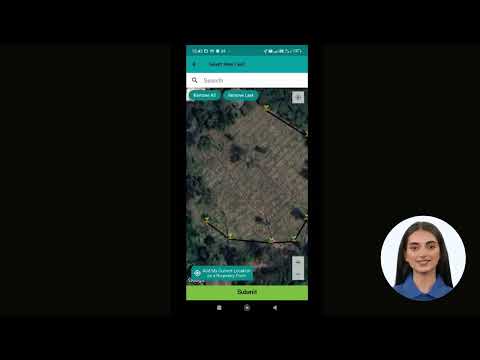How to Scout and Manage Colorado Potato Beetles: A Step-by-Step Guide for Sustainable Farming

“Colorado potato beetles can lay up to 500 eggs in their lifetime, making early detection crucial for effective control.”
Welcome to our comprehensive guide on scouting and managing Colorado potato beetles using sustainable farming practices and cutting-edge technology. As agricultural experts at Farmonaut, we understand the challenges posed by this persistent pest and are here to provide you with effective strategies to protect your potato crops. In this blog post, we’ll explore integrated pest management techniques, leveraging our AI-powered pest prediction models and innovative crop scouting app to help you maximize yields while minimizing environmental impact.
Understanding the Colorado Potato Beetle
The Colorado potato beetle (Leptinotarsa decemlineata) is a formidable pest that can cause significant damage to potato crops, as well as other plants in the nightshade family such as eggplants and peppers. These beetles are known for their voracious appetite and ability to reproduce rapidly, making them a constant threat to farmers worldwide.
- Adult beetles are easily recognizable by their oval shape and distinctive yellow-orange coloration with black stripes.
- Larvae are reddish-orange with black spots and can consume large amounts of foliage as they grow.
- A single female can lay hundreds of eggs in a season, leading to multiple generations per year in warm climates.
The Importance of Early Detection and Sustainable Management
Effective control of Colorado potato beetles begins with early detection and a proactive management approach. By implementing sustainable farming practices and utilizing precision agriculture technology, we can reduce reliance on chemical pesticides while maintaining crop health and productivity.
At Farmonaut, we’ve developed advanced tools to assist farmers in this crucial task:
- AI-powered pest prediction models
- Satellite-based crop health monitoring
- User-friendly crop scouting app
These technologies work together to provide timely, data-driven insights that enable more efficient and environmentally friendly pest management strategies.
Step-by-Step Guide to Scouting for Colorado Potato Beetles
Effective scouting is the foundation of any successful pest management program. Here’s how to scout for Colorado potato beetles using Farmonaut’s crop scouting app:
- Set up your field in the app: Begin by mapping your potato fields using our easy-to-use interface. This allows for precise location tracking and data collection.
- Establish a scouting schedule: Our AI models will suggest optimal scouting times based on growing degree days (GDD) and predicted pest life cycles.
- Conduct regular field walks: Use a zigzag pattern to cover the entire field, paying close attention to field edges where infestations often begin.
- Check the underside of leaves: Look for egg masses, which appear as bright yellow-orange clusters.
- Count and record pest numbers: Use our app to log the number of eggs, larvae, and adult beetles found per plant.
- Monitor for damage: Record any signs of defoliation or plant stress in the app.
- Upload data in real-time: Our system will analyze your findings and provide immediate recommendations.
By following these steps and utilizing our technology, you’ll be able to detect infestations early and take timely action.
Leveraging AI for Pest Prediction and Management
Farmonaut’s AI-powered pest prediction models are a game-changer in the fight against Colorado potato beetles. Here’s how our technology helps you stay one step ahead:
- GDD-based forecasting: Our models use growing degree days to predict key stages in the beetle’s life cycle, allowing for more precise timing of control measures.
- Customized alerts: Receive notifications when conditions are optimal for egg-laying, larval emergence, or adult activity.
- Treatment timing optimization: Get recommendations for the best times to apply treatments based on pest development and weather conditions.
- Resistance management: Our system helps you rotate control methods to prevent pesticide resistance.
By integrating these AI-driven insights into your pest management strategy, you can significantly improve the efficiency and effectiveness of your control efforts.
Integrated Pest Management Strategies for Colorado Potato Beetles
A successful approach to managing Colorado potato beetles involves combining various control methods. Here are some key strategies to implement:
Cultural Control
- Crop rotation: Plant potatoes in different fields each year to disrupt the beetle’s life cycle.
- Planting timing: Use our GDD models to determine optimal planting dates that avoid peak beetle activity.
- Trap crops: Plant small areas of early-maturing potato varieties to attract and concentrate beetles for easier control.
Biological Control
- Natural predators: Encourage beneficial insects like lady beetles and lacewings that feed on potato beetle eggs and larvae.
- Parasitic wasps: Release parasitoids that target potato beetle eggs and larvae.
- Microbial control: Apply Bacillus thuringiensis var. tenebrionis (Bt) for effective control of young larvae.
Mechanical Control
- Hand-picking: For small gardens or organic operations, manually remove beetles and egg masses.
- Row covers: Use floating row covers to protect young plants during the early season.
Chemical Control
When necessary, use pesticides judiciously and in rotation to prevent resistance:
- Selective insecticides: Choose products that target Colorado potato beetles while minimizing impact on beneficial insects.
- Timing applications: Use our AI predictions to apply treatments when beetles are most vulnerable.
- Resistance management: Rotate between different modes of action as recommended by our app.
“Farmonaut’s AI-powered pest prediction models use growing degree days (GDD) to forecast optimal treatment times for Colorado potato beetles.”
Implementing Sustainable Farming Practices with Farmonaut
At Farmonaut, we’re committed to helping farmers adopt sustainable practices that protect both crops and the environment. Our precision agriculture technology supports this goal in several ways:
- Reduced pesticide use: By providing accurate pest predictions and targeted treatment recommendations, we help minimize unnecessary pesticide applications.
- Optimized resource allocation: Our satellite-based crop health monitoring allows for precise application of inputs only where and when they’re needed.
- Data-driven decision making: Access to real-time field data and AI-powered insights enables more informed and sustainable farming practices.
By integrating these sustainable approaches with our advanced technology, you can effectively manage Colorado potato beetles while promoting long-term soil health and ecosystem balance.

Maximizing the Benefits of Farmonaut’s Crop Scouting App
Our crop scouting app is designed to streamline your pest management efforts and provide valuable insights. Here’s how to make the most of its features:
- Regular data input: Consistently record your scouting observations to improve the accuracy of our AI predictions.
- Utilize mapping tools: Create detailed field maps to track pest hotspots and treatment areas.
- Set custom alerts: Configure notifications for specific pest thresholds or crop growth stages.
- Review historical data: Analyze past seasons’ data to identify trends and refine your management strategies.
- Collaborate with team members: Share scouting tasks and insights across your farm team for coordinated management efforts.
By fully leveraging these features, you’ll be able to develop a more proactive and efficient approach to Colorado potato beetle management.
Colorado Potato Beetle Life Cycle and Management Timeline
| Beetle Life Stage | Growing Degree Days (GDD) | Visual Indicators | Management Actions |
|---|---|---|---|
| Egg Laying | 185-200 | Yellow-orange egg clusters on leaf undersides | Begin intensive scouting; consider applying ovicides |
| First Instar Larvae | 300-350 | Small, dark red larvae on leaves | Apply Bt or other selective insecticides if thresholds are exceeded |
| Second-Fourth Instar Larvae | 350-600 | Larger orange larvae with black spots | Continue scouting; apply larvicides if necessary; encourage natural predators |
| Pupation | 600-800 | Larvae enter soil to pupate | Prepare for adult emergence; consider soil treatments |
| Adult Emergence | 800-900 | Striped yellow-orange beetles on plants | Monitor for new egg masses; apply adulticides if thresholds are met |
This timeline serves as a general guide. Use Farmonaut’s AI-powered predictions for more precise timing based on your specific field conditions.
Enhancing Your Pest Management with Farmonaut’s Advanced Features
To further improve your Colorado potato beetle management, consider these advanced features offered by Farmonaut:
- Satellite-based vegetation analysis: Monitor crop health remotely to detect potential stress caused by pest infestations.
- Weather integration: Access hyper-local weather forecasts to plan scouting and treatment activities.
- Resistance tracking: Log treatment efficacy over time to identify potential resistance development.
- Yield prediction: Estimate potential yield impacts based on pest pressure and management actions.
These tools work in concert with our core scouting and prediction features to provide a comprehensive pest management solution.
Best Practices for Long-Term Colorado Potato Beetle Management
To ensure sustainable control of Colorado potato beetles over multiple growing seasons, consider these long-term strategies:
- Diversify crop rotations: Include non-host crops in your rotation to break the pest cycle.
- Maintain field records: Use Farmonaut’s app to keep detailed records of pest populations, treatments, and results for year-over-year analysis.
- Collaborate with neighbors: Coordinate management efforts with nearby farms to reduce overall pest pressure in the area.
- Stay informed: Regularly check for updates to our AI models and pest management recommendations.
- Invest in soil health: Healthy soils promote resilient plants that can better withstand pest pressure.
By implementing these practices and consistently using Farmonaut’s technology, you’ll be well-equipped to manage Colorado potato beetles effectively and sustainably.
Conclusion: Empowering Sustainable Potato Farming with Farmonaut
Managing Colorado potato beetles is a complex but crucial aspect of successful potato cultivation. By integrating Farmonaut’s precision agriculture technology with sustainable farming practices, you can significantly improve your ability to protect your crops while minimizing environmental impact.
Our AI-powered pest prediction models, user-friendly crop scouting app, and satellite-based monitoring tools provide the insights and support you need to make informed decisions throughout the growing season. By following the step-by-step guide and best practices outlined in this blog post, you’ll be well on your way to achieving better pest control outcomes and higher yields.
Remember, effective Colorado potato beetle management is an ongoing process that requires vigilance, adaptability, and the right tools. With Farmonaut as your partner in precision agriculture, you’ll have the technology and expertise needed to face this challenge head-on and thrive in the ever-evolving world of sustainable farming.
Ready to revolutionize your approach to potato beetle management? Explore Farmonaut’s solutions today and take the first step towards more efficient, sustainable, and productive farming.
FAQs about Colorado Potato Beetle Management
- Q: How often should I scout for Colorado potato beetles?
A: We recommend scouting at least twice a week during the growing season, with more frequent checks during peak pest activity periods as indicated by our AI prediction models. - Q: Can Colorado potato beetles develop resistance to pesticides?
A: Yes, these beetles are known for rapidly developing resistance. That’s why Farmonaut’s app helps you rotate between different control methods and pesticide modes of action. - Q: Are there any natural predators of Colorado potato beetles?
A: Yes, several natural predators can help control beetle populations, including lady beetles, ground beetles, and some species of stink bugs. Our sustainable farming practices encourage these beneficial insects. - Q: How does Farmonaut’s satellite monitoring help with pest management?
A: Our satellite technology detects changes in crop health that may indicate pest infestations, allowing for early intervention before significant damage occurs. - Q: Can I use Farmonaut’s tools for crops other than potatoes?
A: Absolutely! While this guide focuses on potato beetles, our technology is applicable to a wide range of crops and pest management scenarios.
For more information on our API and developer resources, visit our API page and API Developer Docs.






